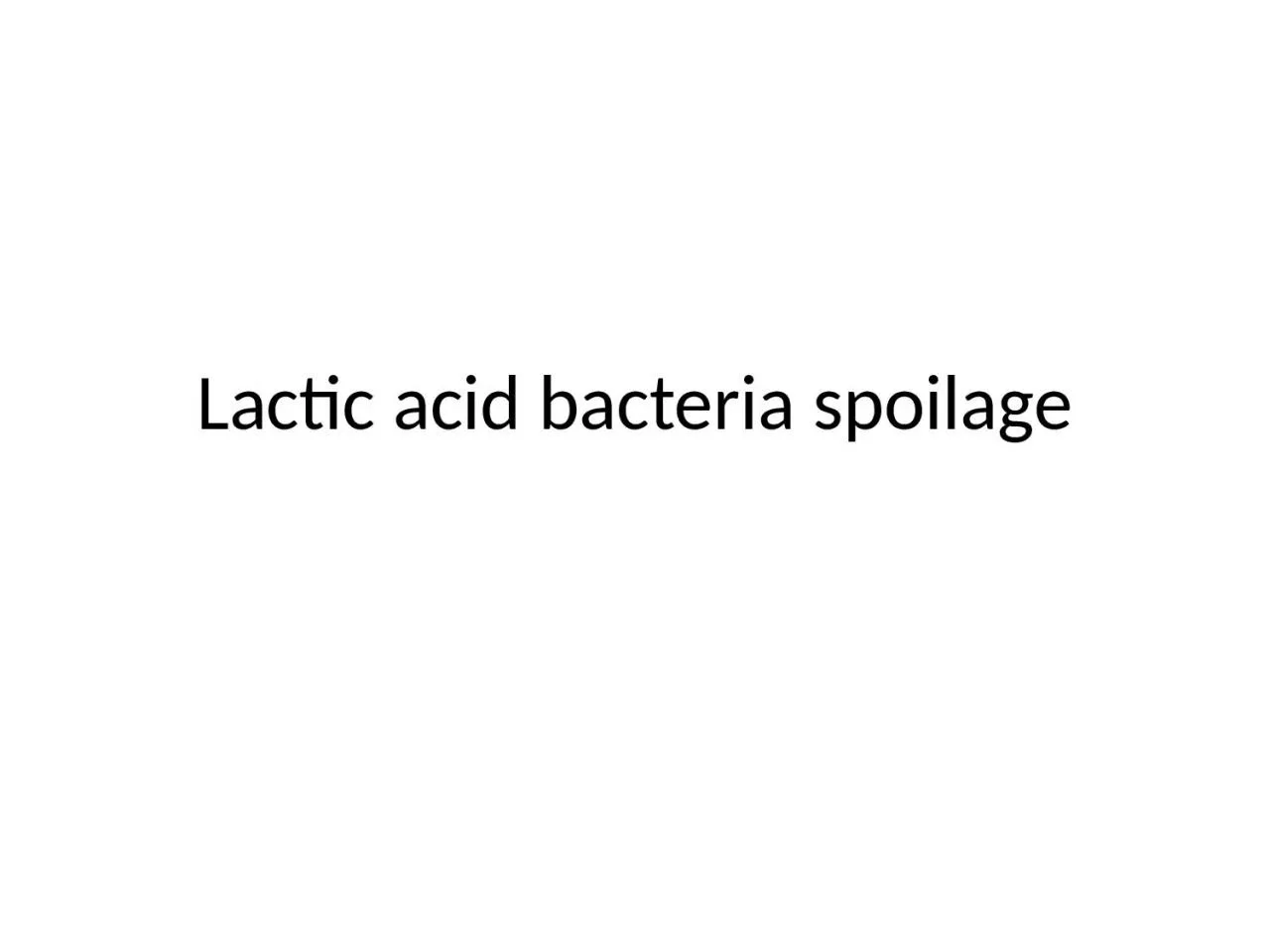

What are LABs Lactococcus sp Lactobacillus sp Leuconostoc sp Pediococcus sp Oenococcus sp Streptococcus sp Enterococcus sp Sporolactobacillus sp Carnobacterium sp ID: 1032559
Download Presentation The PPT/PDF document "Lactic acid bacteria spoilage" is the property of its rightful owner. Permission is granted to download and print the materials on this web site for personal, non-commercial use only, and to display it on your personal computer provided you do not modify the materials and that you retain all copyright notices contained in the materials. By downloading content from our website, you accept the terms of this agreement.
1. Lactic acid bacteria spoilage
2. What are LABs?Lactococcus sp.Lactobacillus sp.Leuconostoc sp.Pediococcus sp.Oenococcus sp.Streptococcus sp.Enterococcus sp.Sporolactobacillus sp.Carnobacterium sp.Aerococcus sp.Tetragenococcus sp.Vagococcus sp.Weisella sp.Sugars lactic acidFermentative
3. Physiologic featuresLactic acid main end productLimited capacity to synthesize amino acids, vitamins (esp. Lactobacillus, Lactococcus)Lb. johnsonii can’t make any amino acids, for exampleStrictly fermentative metabolismNo cytochromes, etc.Energy generated by substrate-level phosphorylationMany prefer lack of oxygenMany lack catalase, superoxide dismutase, other enzymes for dealing with oxygen radicals.More acid resistant (in general) than aerobic spoilage bacteria (especially lactobacilli)
4. Spoilage or beneficial?ProcessBeneficial (controlled)Detrimental (uncontrolled)Conversion of sugars to lactic acid Acid flavor in fermented meats and dairy products Sourness of fresh meats, pasteurized milkMalty flavor (3-methylbutanal)Malt powderPasteurized milkRopiness (exopolysaccharides)YogurtMeats, milkAcetaldehyde (product of threonine catabolism)Yogurt (green apple flavor)MilkDiacetylButtermilk (butter flavor)Fresh milk
5.
6. Homofermentative lactose utilizationlactosegalactose-6-Pglucosephospho-b-galactosidaseglucose-6-Pfructose-6-Pfructose-1,6-diPtagatose-6-Ptagatose-1,6-diP4 triose-PATPADPATPADPLactococcus lactisEmbden-Meyerhoff pathwaytagatose pathway
7. 4 triose-P4 pyruvic acid4 ADP4 ATP4 lactic acidLactose 2 ATP + 4 lactic acid
8. Heterofermentative lactose utilizationlactosegalactoseglucoseb-galactosidase2 glucose-6-PATPADPATPADPSome lactobacilli
9. 2 glucose-6-P2 xyulose-5-P2 CO22 acetyl phosphateacetateATPADPacetaldehydeethanol2 triose-P2 pyruvic acid2 lactic acid
10. Spoilage or beneficial?ProcessBeneficial (controlled)Detrimental (uncontrolled)Conversion of sugars to lactic acid Acid flavor in fermented meats and dairy products Sourness of fresh meats, pasteurized milkMalty flavor (3-methylbutanal)Malt powderPasteurized milkRopiness (exopolysaccharides)YogurtMeats, milkAcetaldehyde (product of threonine catabolism)Yogurt (green apple flavor)MilkDiacetylButtermilk (butter flavor)Fresh milk
11. AcetaldehydeFrom L-threonineThreonine aldolaseIn yogurt, mainly L. delbrueckii subsp. bulgaricuschemistry.about.comacetaldehydeglycinethreonineethanol
12. Second pathway to acetaldehydeFig 4.3 from Microbiology and technology of fermented foods (R. Hutkins)
13. Branched chain amino acid catabolismhttp://femsre.oxfordjournals.org/content/29/3/591Lactococcus lactis subsp. lactis biovar maltigenes
14. Diacetyl productionFrom citrateMovie popcorn; common in buttermilks (L. lactis subsp. lactis biovar. diacetylactis)Functions often plasmid-encodedcitrate (C6)oxaloacetate (C4)pyruvate (C3)a-acetolactate (C5)acetoin (C4)diacetyl (C4)http://www.biokemi.org/biozoom/issues/522/articles/2368Acetate (C2)CO2CO2CO2non-enzymatic
15. Ropiness50-5000 monomersGlucose and galactose most commonAlso rhamnose, mannose, fucose, arabinose, xylose, N-acetylglucosamine, N-acetylgalactosamineHomopolysaccharidesDextrans, mutans, fructansHeteropolysaccharidesExtracellular polysaccharides (EPS)Capsular polysaccharides (CPS)Ropy polysaccharideshttp://www.healthyfacilitiesinstitute.com/p_281-Biofilm
16. Snapshot of EPS diversity (yogurt LAB)OrganismstrainExopolysaccharide compositionSugar ratios in subunitsLb. delbrueckii subsp. bulgaricus LY03, rr, Lfi5Glucose, galactose, rhamnoseGal:Glu:Rha; 5:1:1291Glucose, galactoseGlu:Gal; 3:2Streptococcus thermophilusSY89, SY102, SFi39, Glucose, galactoseGal:Glu; 1:1IMD01, CNCMIGlucose, galactoseGal:Glu; 3:1SFi 2Galactose, rhamnose, glucoseGal:Rha:Glu; 3:2:1MR-ICGalactose, rhamnose, fucoseGal:Rha:Fuc; 5:2:1OR 901Galactopyranose, rhamnopyranoseGalP:RhaP; 5:2
17. Importance of EPS production for yogurt productionIncreases viscosityReduce syneresisSave money:Decrease milk solids added prior to heating Increase water content“Clean” label
18.